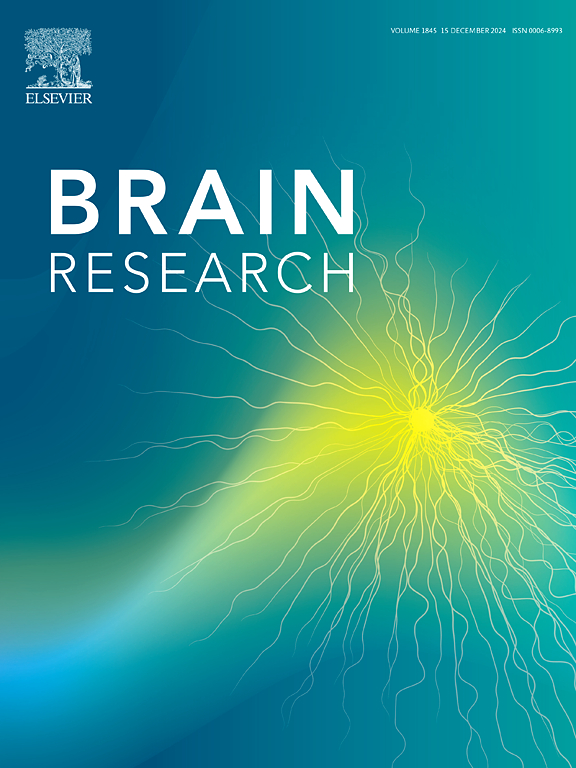The impact of noise on auditory processing in children and adults: A time–frequency analysis perspective
IF 2.7
4区 医学
Q3 NEUROSCIENCES
引用次数: 0
Abstract
Objective
The current study investigated the impact of listening conditions on cortical oscillatory activities in adults and children.
Experimental procedure
Fifteen adults and 15 children participated in this study. Electrophysiological measures were recorded with 64 electrodes. Stimulation was presented binaurally with parameters modulation: stimuli, listening conditions, noise and SNR. Intertrial phase clustering (ITPC) and power values were computed using spatially filtered data and complex Morlet wavelets. Data were statistically analyzed with mixed factorial ANOVAs.
Results
In quiet, children exhibited stronger theta-alpha (ta-) ITPC than adults, especially for verbal stimuli, in bilateral temporal regions, while adults showed no regional differences. Beta-gamma (bg-) ITPC responses revealed that tonal stimuli only elicited stronger right temporal responses in children. Theta-alpha power was greater for tonal stimuli in children, while adults showed stronger right temporal responses. In noise, ta-ITPC reductions were more pronounced in children, especially in babble noise. In white noise, unlike babble noise, there was a systematic reduction of the ta-ITPC values as a function of the SNR level. The bg-ITPC responses were also weaker at lower than higher SNRs. Ta-Power was lower for tonal than verbal stimuli at the right electrode, with greater reductions in babble than in white noise. Bg-Power differences were observed only at the central electrode, where adults showed smaller reductions than children.
Discussion
Results indicated that phase and power measures are sensitive to parameter modulation and could be used to understand auditory processing in noise, as they revealed increased susceptibility to noise in children compared to adults.

噪声对儿童和成人听觉加工的影响:时频分析视角
目的探讨听力条件对成人和儿童大脑皮层振荡活动的影响。实验程序15名成人和15名儿童参与了本研究。用64个电极记录电生理指标。刺激以双耳方式呈现,参数调制:刺激、听音条件、噪声和信噪比。利用空间滤波后的数据和复Morlet小波计算了试验间相聚类(ITPC)和功率值。数据采用混合因子方差分析进行统计学分析。结果在安静状态下,儿童双侧颞区β - α (ta-)电位明显高于成人,尤其是在言语刺激下,而成人无区域差异。β - γ (bg-) ITPC反应显示,音调刺激仅在儿童中引起更强的右侧颞叶反应。在儿童中,音调刺激的θ - α能量更大,而成人则表现出更强的右颞反应。在噪音方面,ta-ITPC的减少在儿童中更为明显,尤其是在咿呀学语的噪音中。在白噪声中,与胡言乱语噪声不同,ta-ITPC值作为信噪比水平的函数有系统的降低。在低信噪比下,bg-ITPC的反应也比高信噪比弱。在右电极上,声调刺激的Ta-Power比言语刺激的Ta-Power低,而在胡言乱语刺激下Ta-Power的降低幅度比白噪声刺激大。只在中央电极上观察到Bg-Power的差异,在那里成人的下降幅度小于儿童。结果表明,相位和功率测量对参数调制很敏感,可以用来理解噪声中的听觉处理,因为它们显示儿童对噪声的易感性比成人高。
本文章由计算机程序翻译,如有差异,请以英文原文为准。
求助全文
约1分钟内获得全文
求助全文
来源期刊

Brain Research
医学-神经科学
CiteScore
5.90
自引率
3.40%
发文量
268
审稿时长
47 days
期刊介绍:
An international multidisciplinary journal devoted to fundamental research in the brain sciences.
Brain Research publishes papers reporting interdisciplinary investigations of nervous system structure and function that are of general interest to the international community of neuroscientists. As is evident from the journals name, its scope is broad, ranging from cellular and molecular studies through systems neuroscience, cognition and disease. Invited reviews are also published; suggestions for and inquiries about potential reviews are welcomed.
With the appearance of the final issue of the 2011 subscription, Vol. 67/1-2 (24 June 2011), Brain Research Reviews has ceased publication as a distinct journal separate from Brain Research. Review articles accepted for Brain Research are now published in that journal.
 求助内容:
求助内容: 应助结果提醒方式:
应助结果提醒方式:


